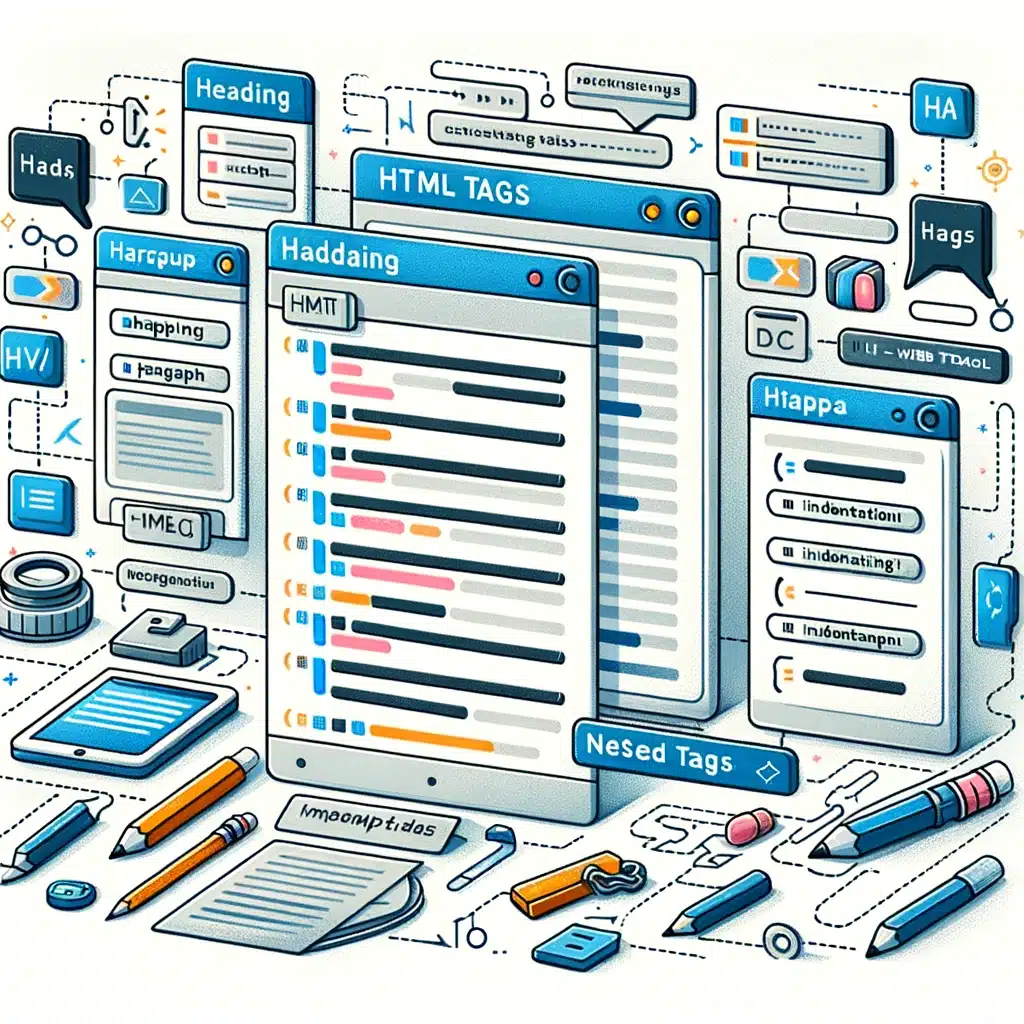
Approx. read time: 3.2 min.
Post: Building a web page with HTML tags
HTML (HyperText Markup Language) is the foundational language for creating web pages, allowing developers to structure content through various tags. This lesson delves into essential HTML tags and their applications in building a well-structured web page.
Basic Structure of an HTML Document
An HTML document begins with a < !DOCTYPE html > declaration, followed by the < html > element that encompasses the entire content. Within < html >, the section contains meta-information, and the < body > section includes the content displayed to users.
< !DOCTYPE html >: Declares the document type and version of HTML.< html lang="en" >: The root element with a language attribute specifying English.< head >: Contains meta-information like character set and title.< meta charset="UTF-8" >: Sets the character encoding to UTF-8.< title >: Defines the title displayed on the browser tab.< body >: Contains the content visible to users.
Text Structuring Tags
HTML provides tags to structure text semantically:
< h1 >to< h6 >: Define headings, with< h1 >as the highest level and< h6 >the lowest.< p >: Defines a paragraph.< br >: Inserts a line break.< strong >: Indicates strong importance, typically displayed in bold.< em >: Denotes emphasized text, usually rendered in italics.
Example:
Nesting and Indentation
Nesting involves placing elements within other elements to create a hierarchical structure. Proper indentation enhances readability and maintainability.
In this example, two < section > elements are nested within the < body >, each containing a heading and additional content.
Lists
HTML supports ordered and unordered lists:
< ul >: Unordered list.< ol >: Ordered list.< li >: List item.
Example:
This creates a bulleted list of features.
Links and Images
< a href="URL" >: Creates a hyperlink.< img src="image.jpg" alt="Description" >: Embeds an image.
Example:
This paragraph includes a hyperlink, and the image tag displays the company logo.
Best Practices
- Use Lowercase Tags: HTML5 is case-insensitive, but using lowercase is a common convention.
- Quote Attribute Values: Enclose attribute values in double quotes.
- Comment Your Code: Use
< !-- Comment -- >to add comments, aiding in code maintenance. - Validate Your HTML: Use tools like the W3C Markup Validation Service to ensure code correctness.
By adhering to these practices, you enhance the readability, accessibility, and maintainability of your web pages.
Conclusion
Mastering HTML tags is fundamental to web development. Understanding the structure and semantics of these tags enables the creation of organized and accessible web pages. Continual practice and adherence to best practices will further develop your proficiency in building complex web structures.
For a comprehensive list of HTML tags and their uses, refer to W3Schools’ HTML Tag Reference.
Note: This lesson is designed to provide a foundational understanding of HTML tags. For more advanced topics, consider exploring CSS for styling and JavaScript for interactivity.
HTML Tutorial – How to Make a Super Simple Website
Learn HTML – Full Tutorial for Beginners (2022)
Related Videos:
Related Posts:
Learn Coding with Milton Marketing Top 20 Programming Languages
Paginate Your WordPress Site Without Plugins
How to secure your Nest account and cameras and keep hackers at bay(Opens in a new browser tab)
HTML paragraph tag: p(Opens in a new browser tab)
HTML, CSS, & JavaScript Essentials of Web Development(Opens in a new browser tab)
Google admits it forgot to tell users about its hidden spy microphone(Opens in a new browser tab)
Coding with HTML – 101 Basics – Great start for beginners(Opens in a new browser tab)
What is a Shortcode in WordPress?









